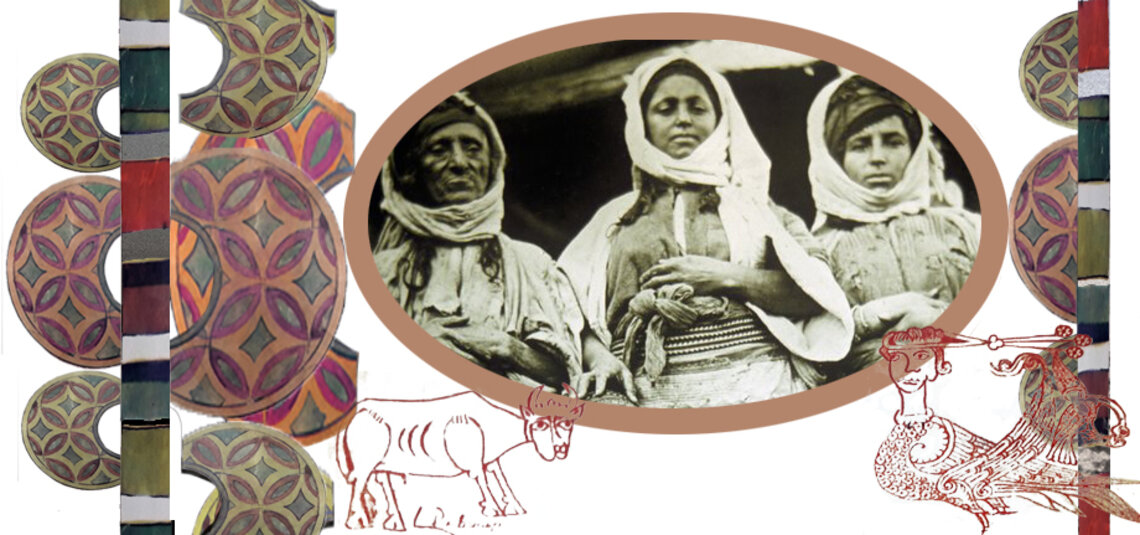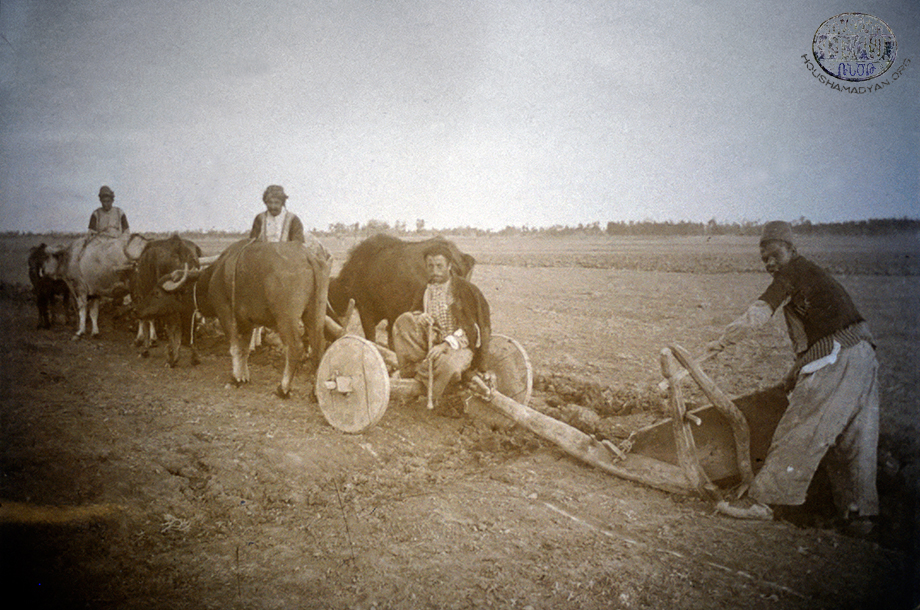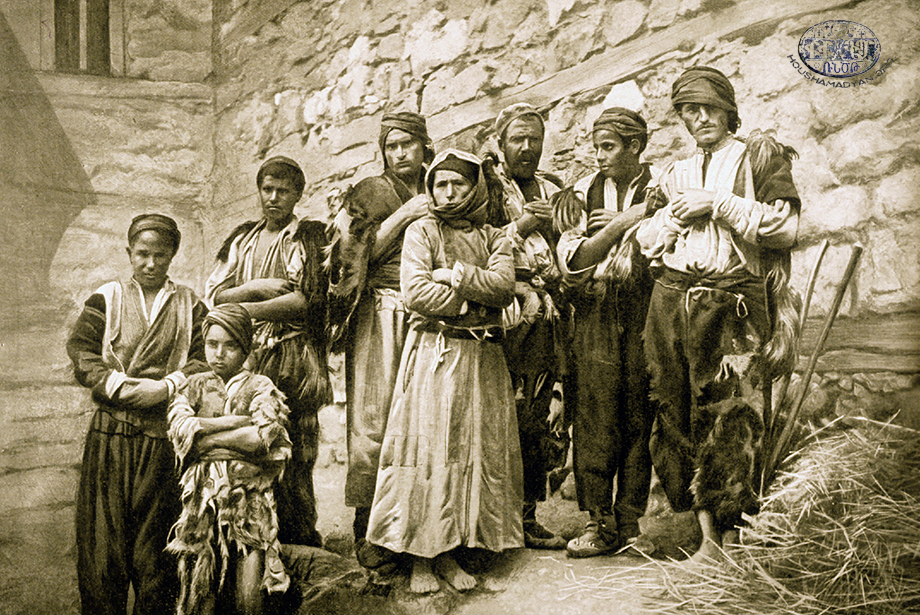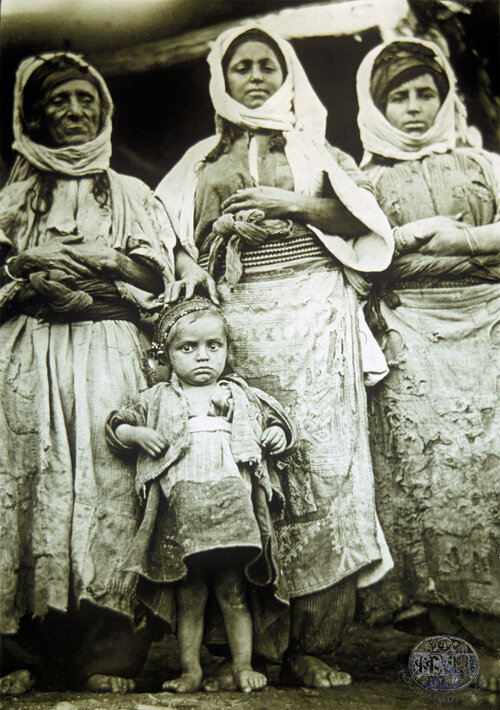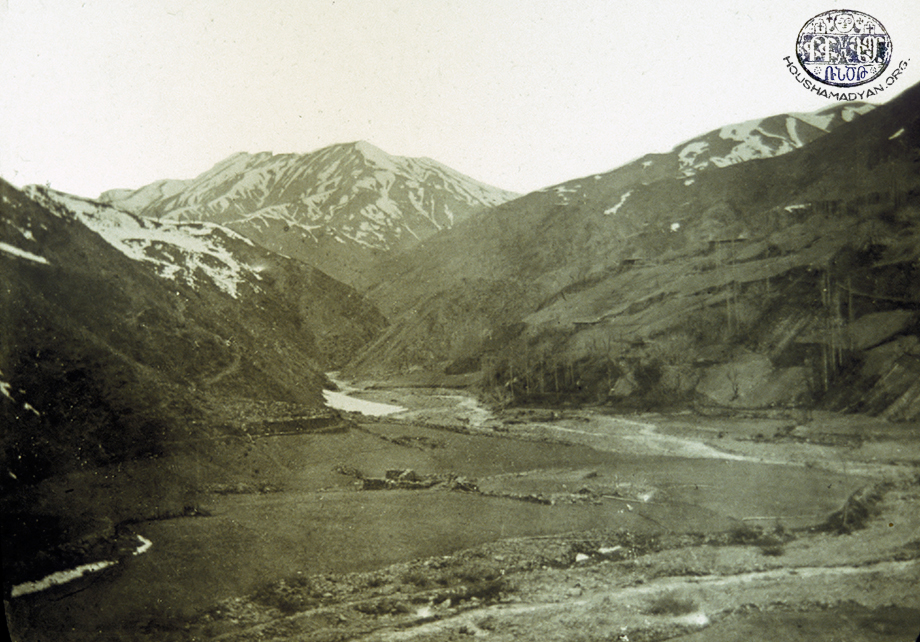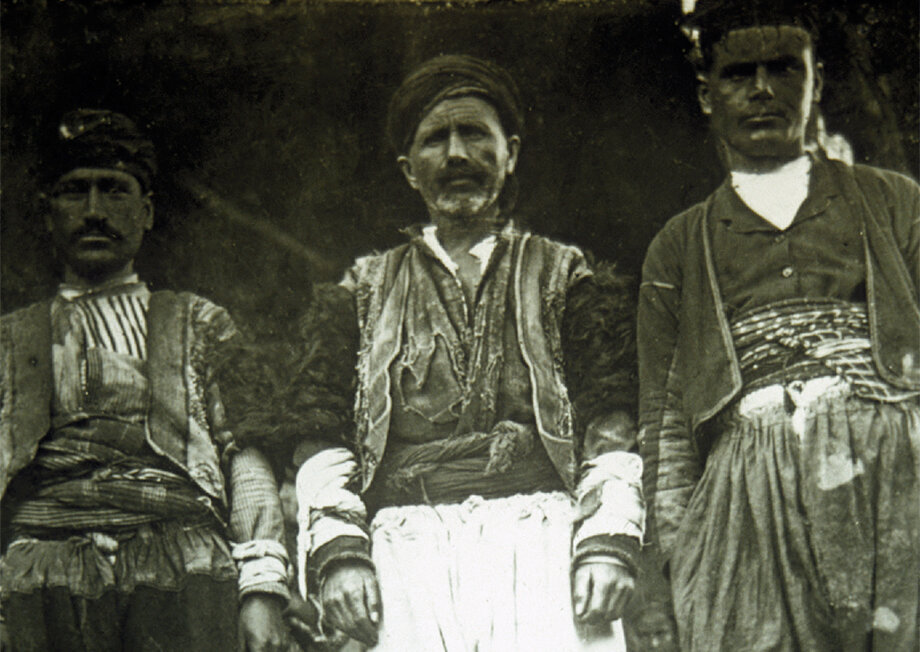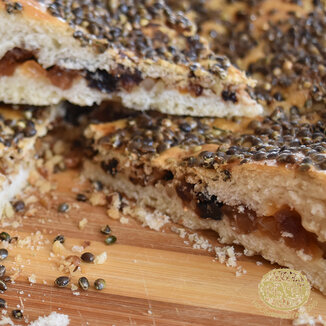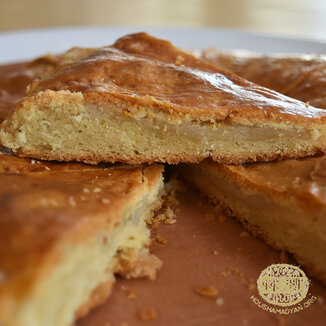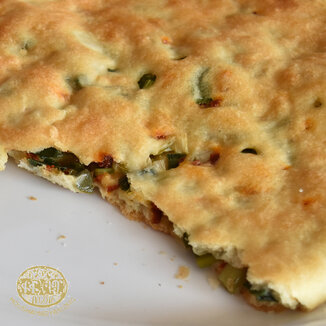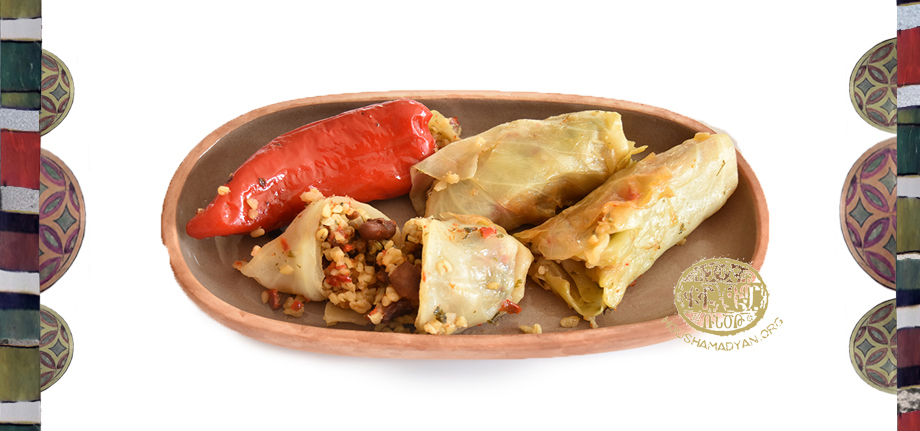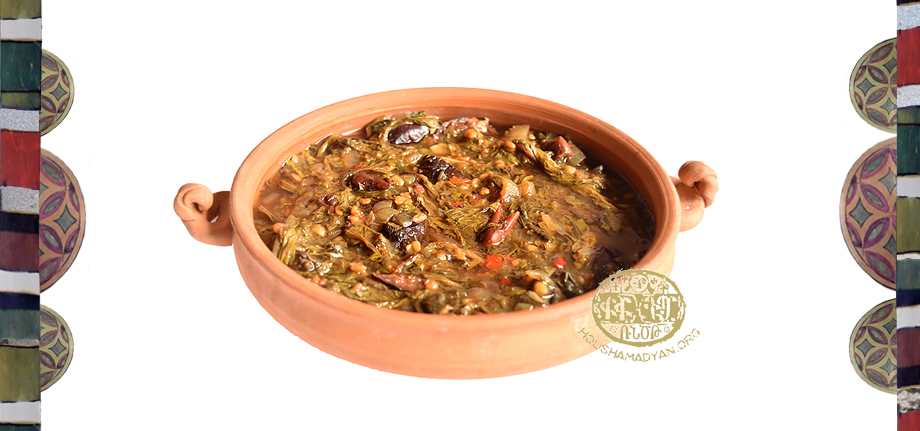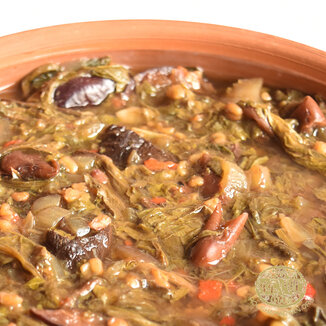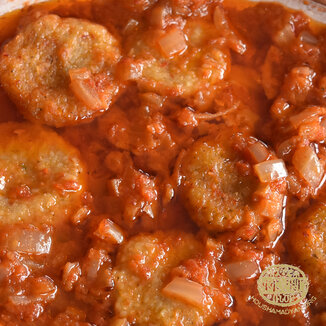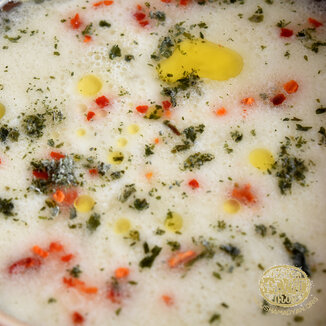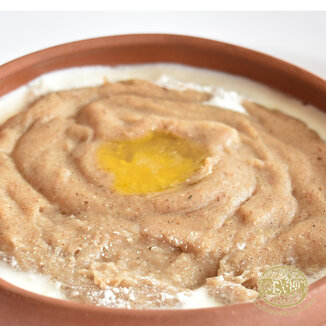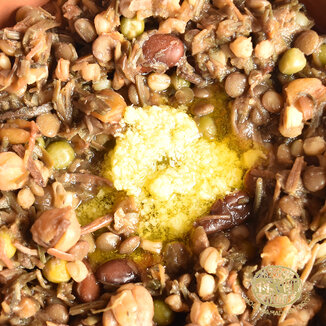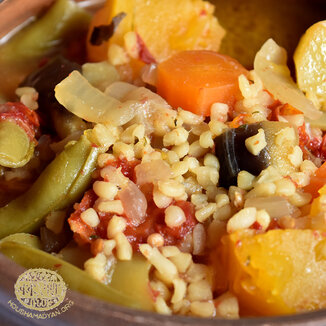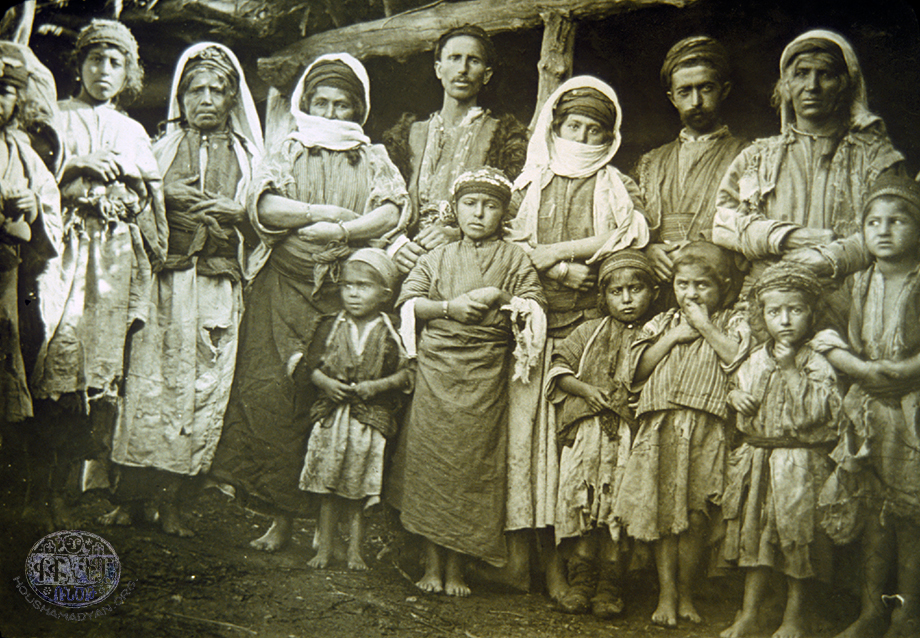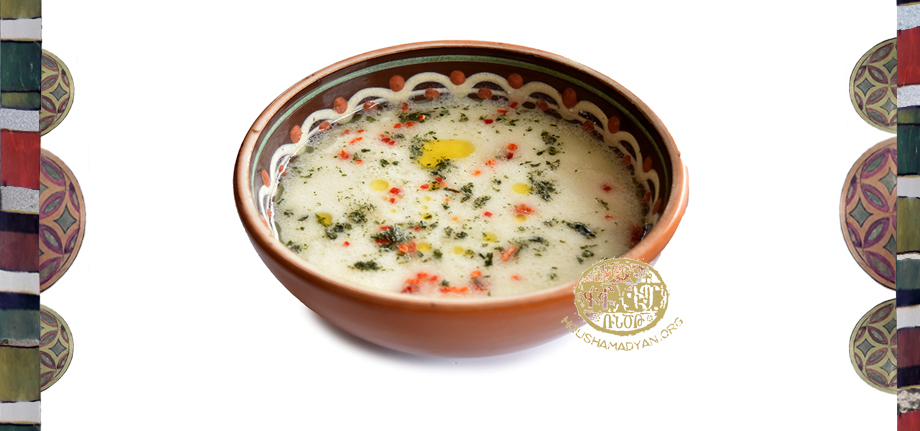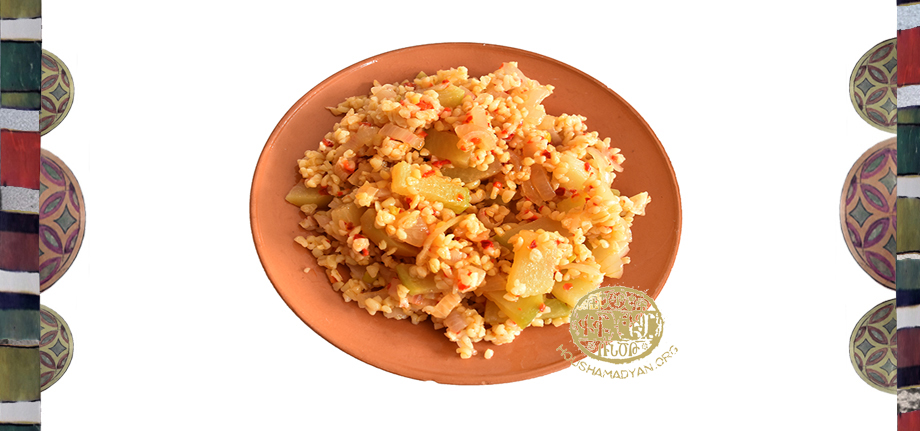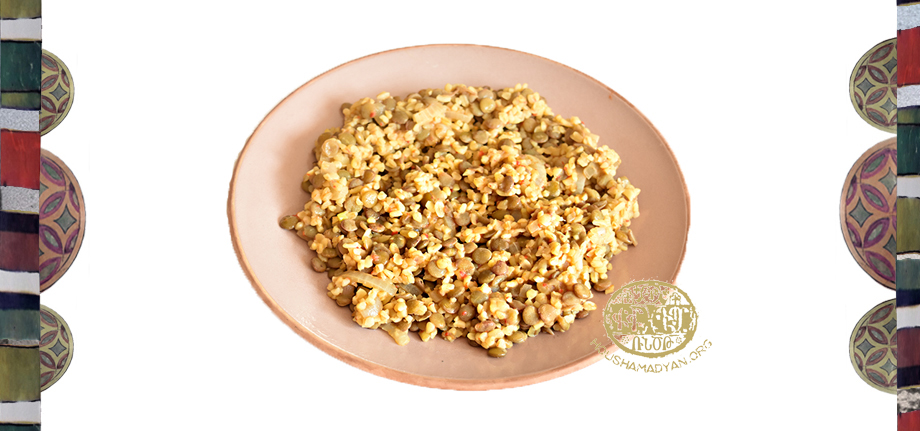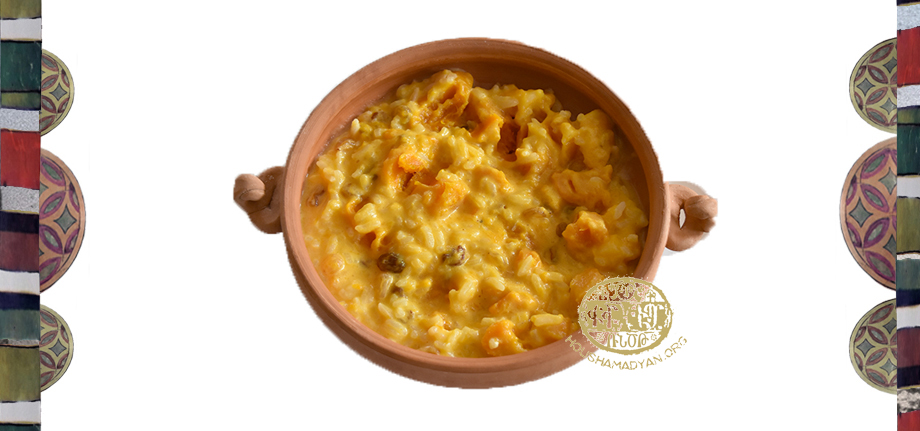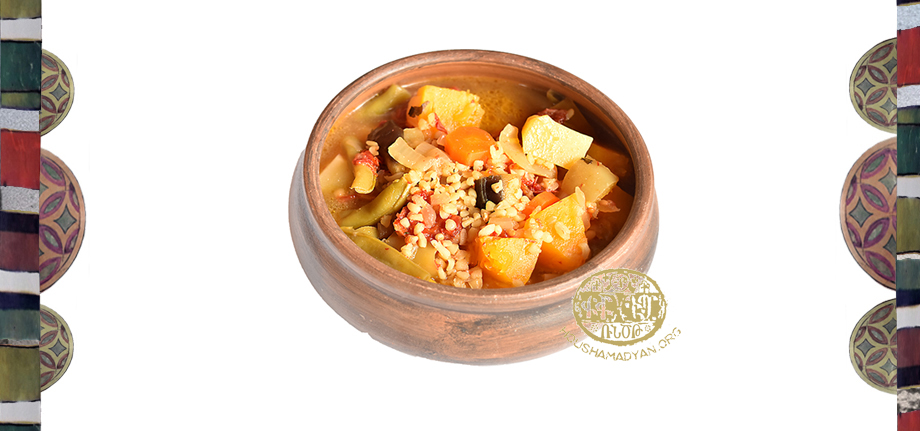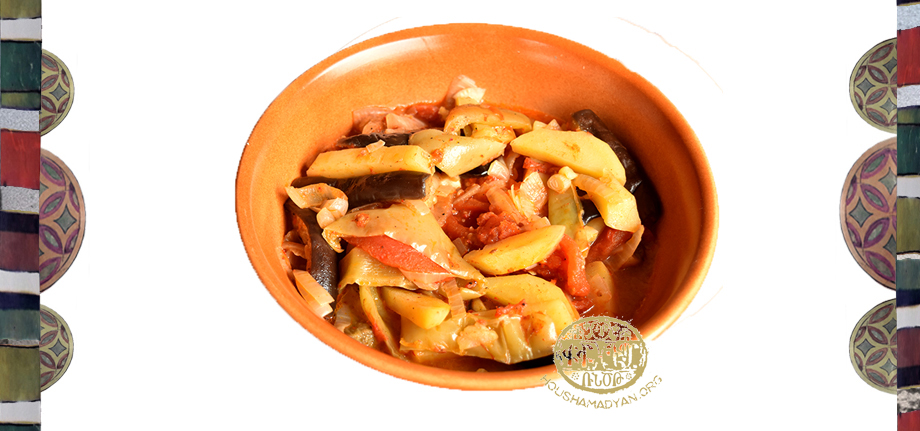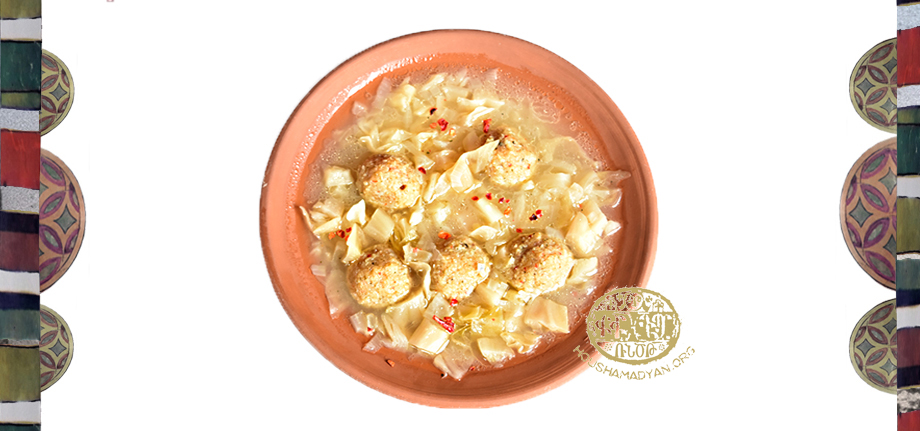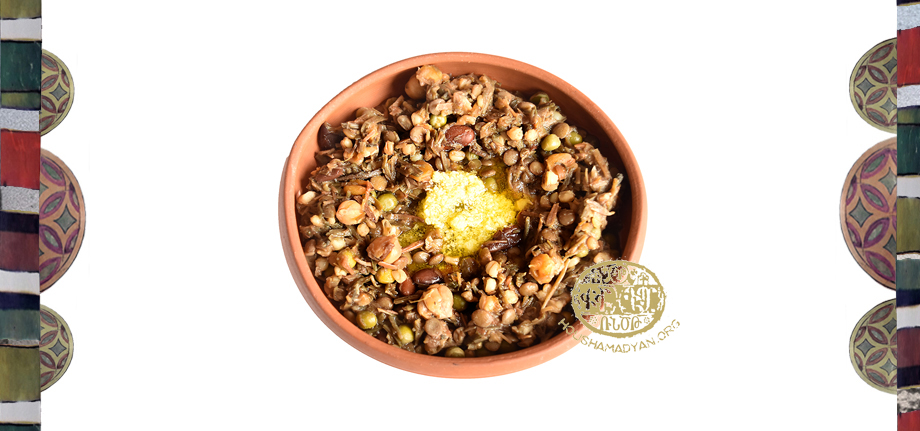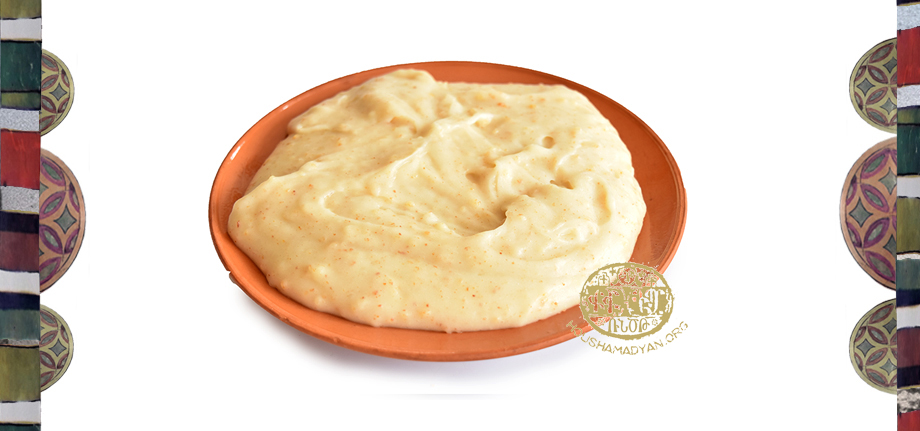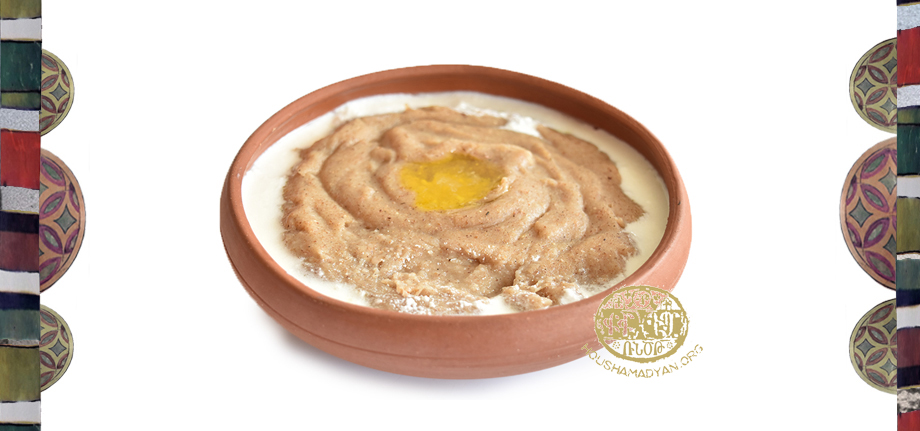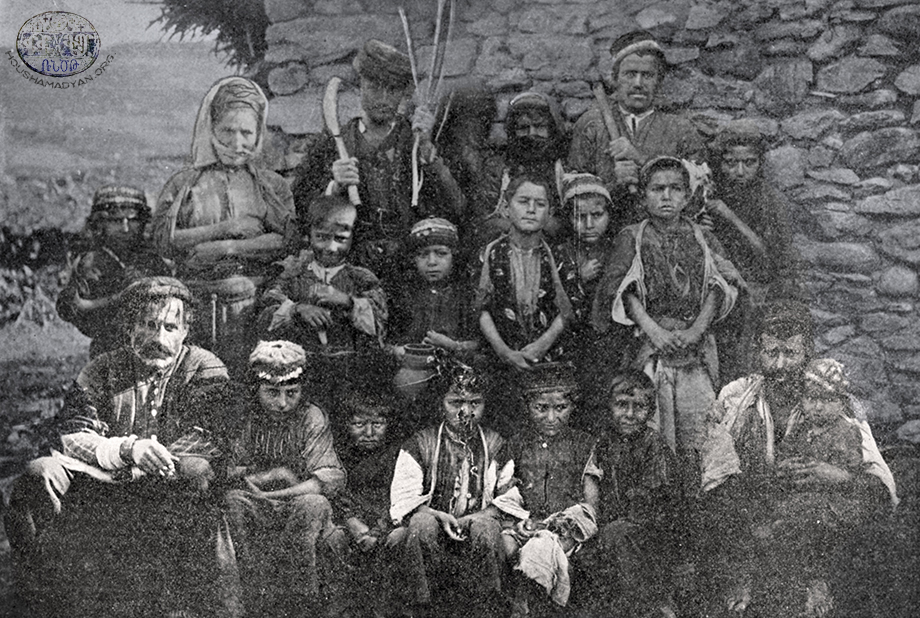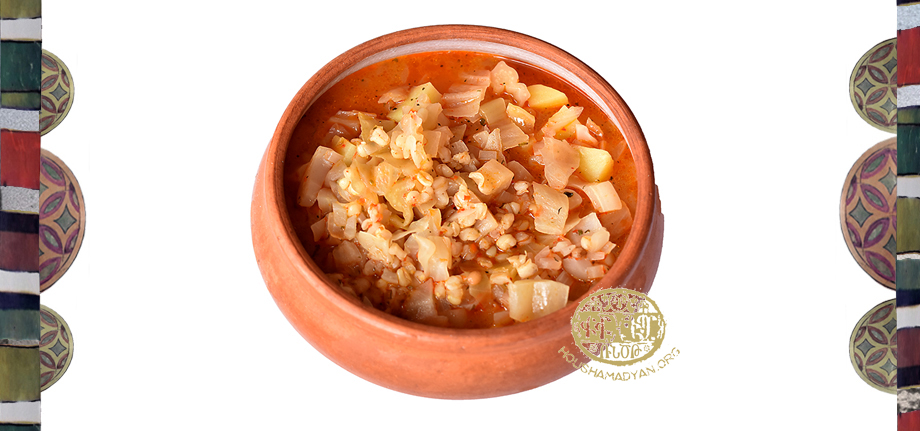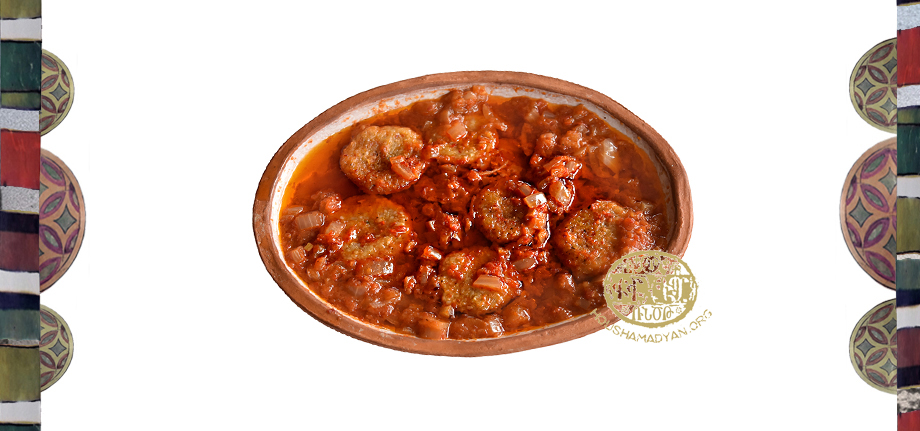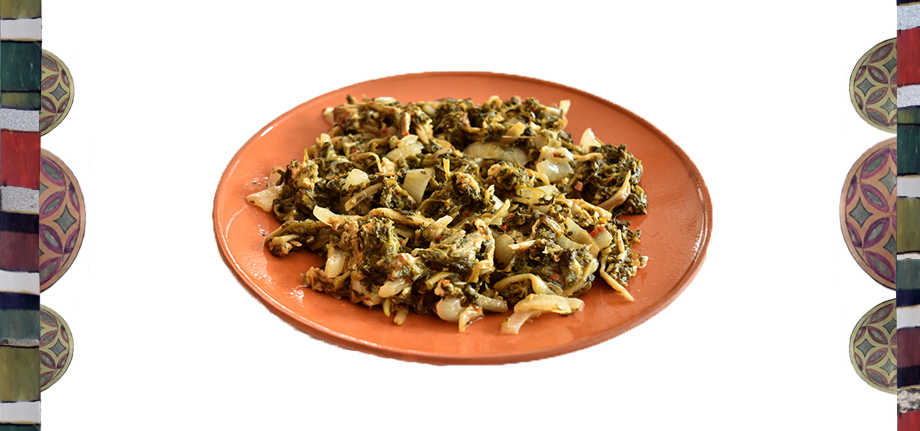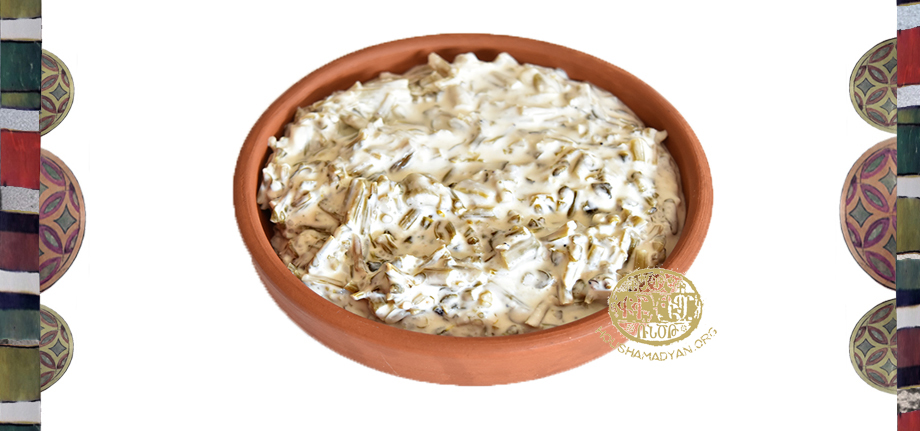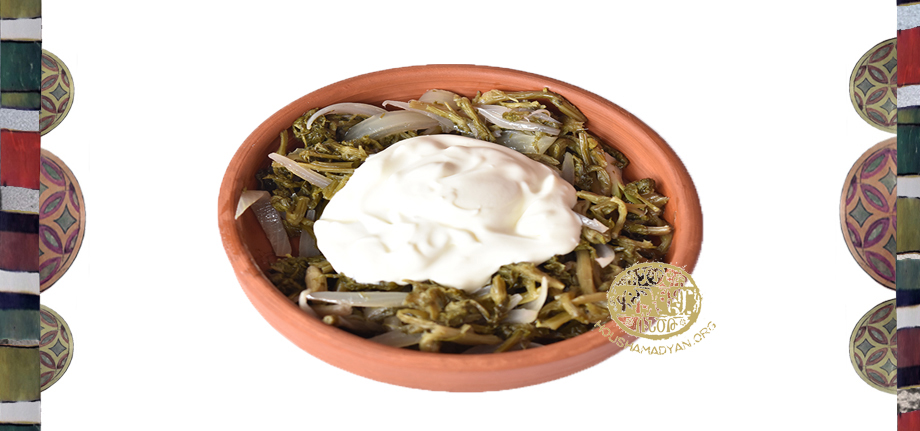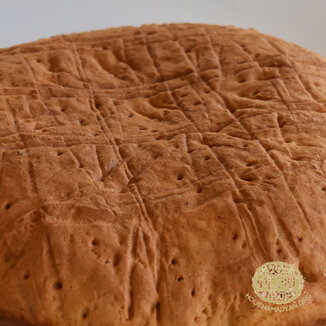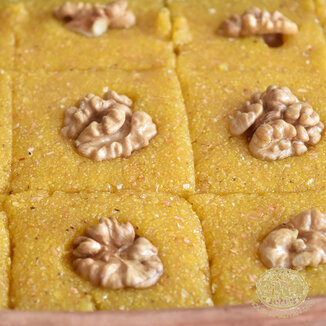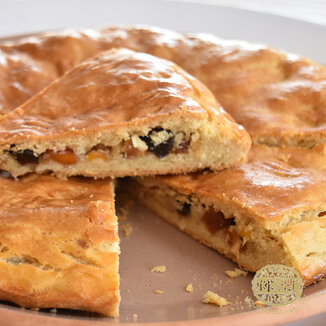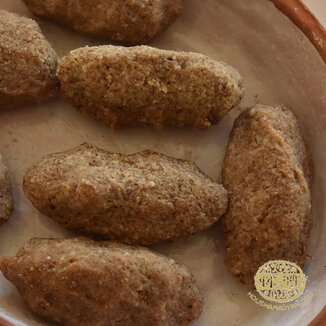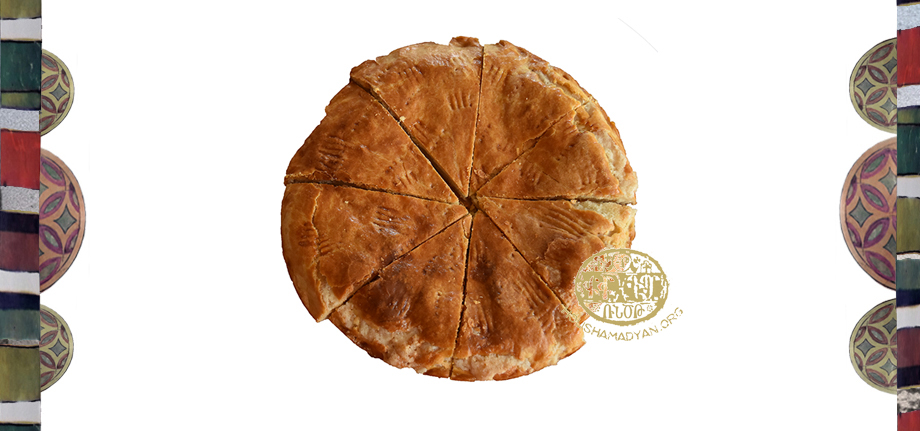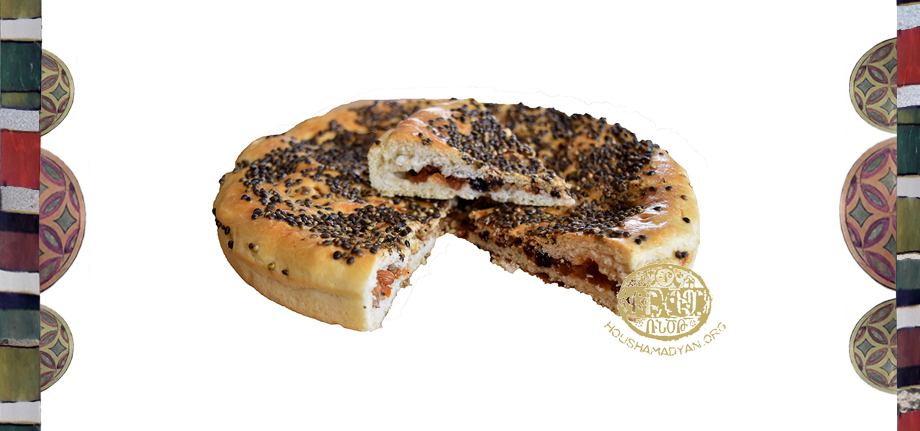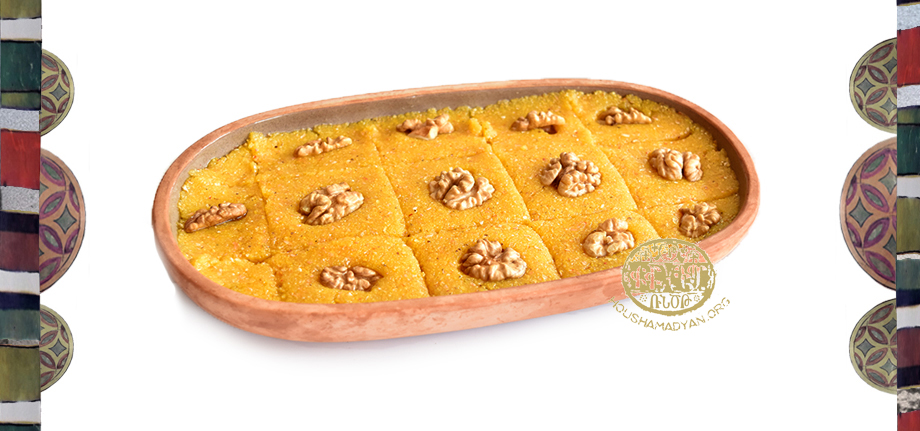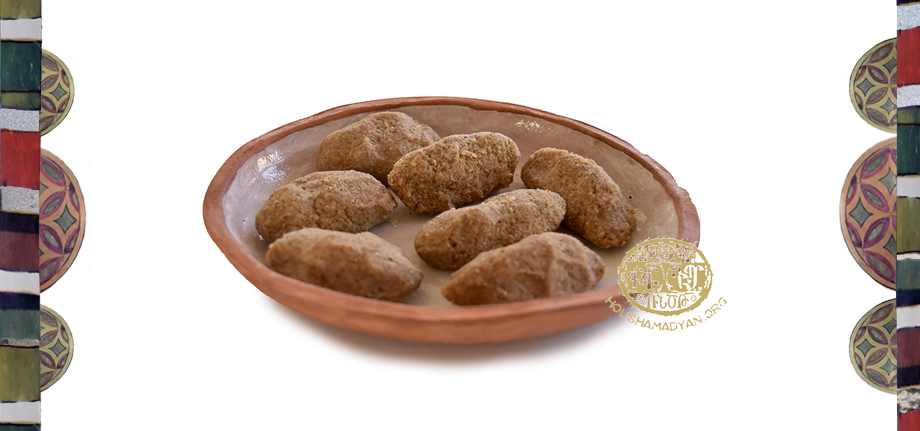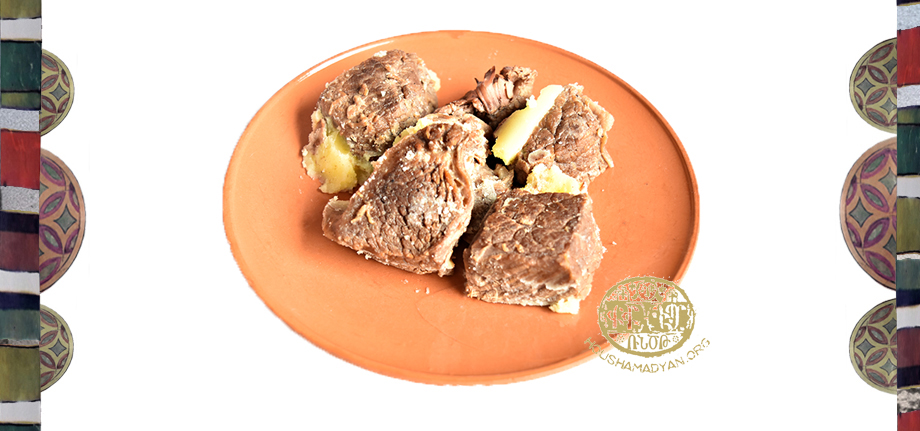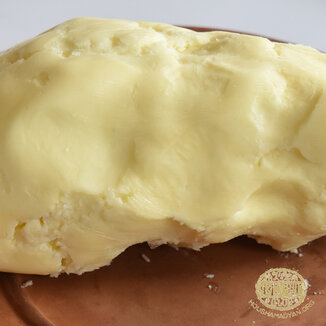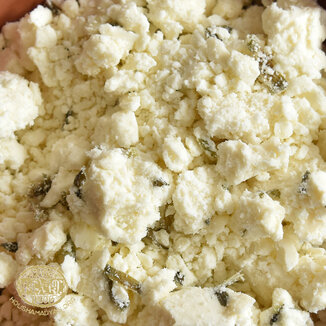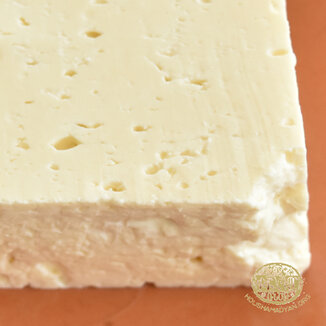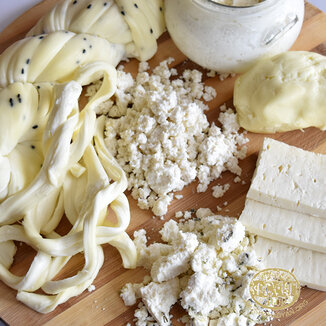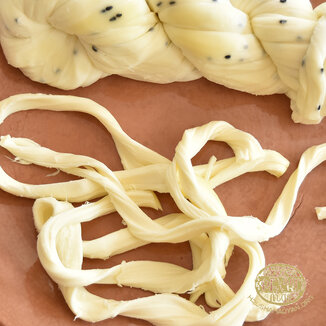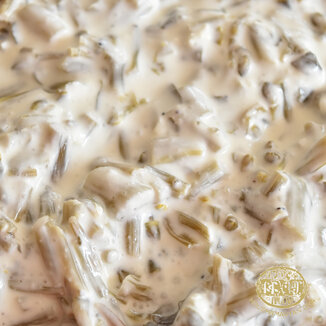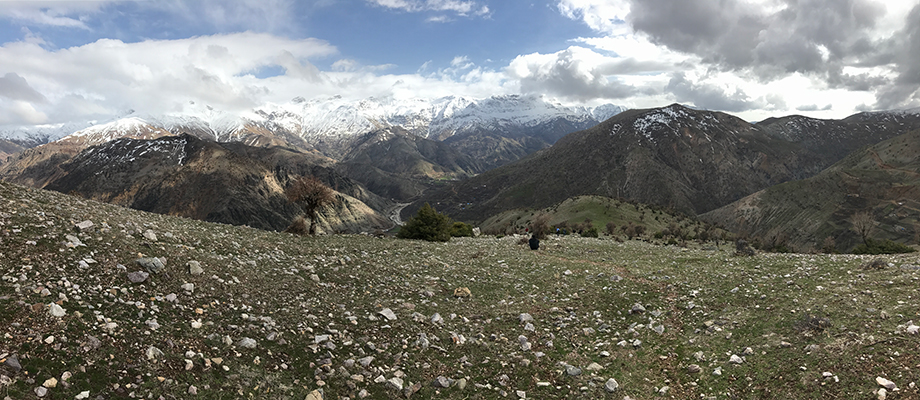Sassoun - Cuisine
Author: Sonia Tashjian, 16/05/18 (Last modified 16/05/18)- Translator: Vahe Habeshian
Sassoun is a district of the state of Aghtznik [of historical Great Armenia]. The plain to its south is the broad basin of Diarbekir, which the locals refer to as the Lower Plain, and to the north is the Plain of Moush, termed the Upper Plain. [1]
Along with the rest of Daron province, Sassoun has an abundance of water: It has large and small lakes, and because of copious amounts of rain and snow many rivulets form in the mountains, and myriad streams and rivers flow down their high peaks. Some of those flow through the territory of Sassoun, including Meghraked [Honey river], Dalvorig river, Sousanna river, Khodzodzvanki chour [Water of Khodzodz Monastery], Zandous stream, Khlhovid stream, Khoutachour [Water of Khout], etc. [2]
Sassoun also has a wealth of dense, large forests. The most common trees are species of oak; also abundant are poplars and willows. The higher elevations are void of fruit-bearing trees, but in the southern regions many types of fruit orchards and vineyards are abundant. [3]
Arable land is scarce in relation to population numbers. For that reason, throughout the centuries they have created level areas of land for planting grains along the crest of every valley, every mountainside, and all open spaces between forests—wherever it's possible to do so. On the slopes of mountains where there is access to water, they've built ramparts with stones, backfilled with soil from areas without access to water, thus creating elevated terraces of arable land.
To maximize crop yield, they sow twice a year: For example, after harvesting barley, they plant millet; or after harvesting wheat, they plant turnip. With climatic conditions in mind, they usually plant the high-yield cereals klkil and millet—including the khashik, khulut, gavars, mourtig, and vazan varieties, among others. They also plant other bread cereals, including varieties of wheat (such as marmous, kosa tsoren, havedig, garmir karnatsan), barley, and chickpeas; legumes, including lentils, beans, peas, and shol (a type of large chickpea); and oil-bearing seeds, including hemp and linseed.
From among vegetables, the most-planted is turnip, also kalam (cabbage), white [sugar] beet, takhdigh (pepper), squash, eggplant/aubergine, tomato, etc.
From the mountains they gather copious amounts of hazelnut and walnut; fruit-bearing trees and bushes produce pear, apricot, plum, apple, azorole, rosehip, grape, oleaster, mulberry, fig, pomegranate, quince, peach, jujube, almond, etc.
In the spring and summer months, the women gather wild mushrooms and varieties of greens (gangar [artichoke], khavurdzil [rhubarb], sbidgoug [possibly, white eremurus], mandag [parsnip chervil], skhdoroug [crow garlic], etc.), some of which they sell; with the remaining wild greens they prepare fritters, salads, and soups, as well as pickling them or drying them for use during the long winters. [4] For home use they extract oil from linseed, hemp, and the tree called mrgit, and for cooking they extract oil from walnuts and the berries of the nettle tree (hackberries). [5]
Many types of grapes grow there. Though the vines are planted in cold regions, at high elevations, they do not bury the vines under soil during winters; rather, the snow covers the vines, protecting them from freezing. Some of the grape harvest is sold, some is made into wine and vodka, and some is preserved by preparing raisins, tuhms (molasses, syrup), mshlour (strung-up confit), and pastigh (fruit leather, dried fruit paste/pastille). Similarly, some of the wild or domesticated fruits are sold or exchanged, and the rest is preserved—dried, made into jam, or made into fruit leather. [6]
Besides agriculture, the main source of sustenance and income is animal husbandry: They raise cows, sheep, goats, and hens. They sometimes also make use of wild animals by hunting them. As a means of transportation, they rely mostly on mules. They secure their meat and milk products, as well as the leather that's so vital for daily needs, from their domesticated animals; the material for leather sacks comes from sheep skins, and the material for leather liquid receptacles comes from goats. They spin the fur and hair of animals into yarn for weaving. During the centuries, various special ways and substances for preparing and tanning leathers have developed. From the large leather liquid receptacles they fashion churns; midsize ones are used for holding milk, yogurt, and tan (a yogurt and water mixture); small ones are used as waterskins to transport yogurt, tan, and water to those working in the fields. [7]
Characteristic of Sassoun is its kazbe—honeydew (manna), which falls during the hottest days of the year, usually in July, at night, like fine rain. In the morning, all of nature—rocks, soil, bushes, trees, and flowers—is covered with the sweet, sticky liquid. There are two ways to collect and process the honeydew. The women go in groups into the forests, where they build an open-air oven/stove; they gather the leafiest oak branches (the manna gathered from other plants tends to be bitter) near the fire, wash the leaves in cauldrons filled with water, then boil that water down until it thickens, storing it in clay carafes or jugs called pghig. They also collect manna from the broad-leafed plant called kaz on which the honeydew forms into large and hardened powder pieces. They carefully slide those into trays, where the pieces of manna stick to each other and form large pieces of sugary manna. Kazbe is in high demand throughout the population of the region, and it's exported to as far as Erzerum/Garin. Particularly during pilgrimages to Saint Garabed of Moush Monastery or the Monastery of the Apostles, the pilgrims take Sassoun manna with them. Not coincidentally, the Armenians of various regions term kazbe "Saint Garabed halva." [8]
The alpine mountainous climate facilitates each family's ownership of a number of beehives, in accordance with the family's means. Often, they bring colonies of wild bees from the forests and domesticate them, terming them "god-given bees." The honey from the region called Houshupi jampa (Dragon's Road) is held in high esteem. [9]
In May, they travel to zoza—summer residences in upland meadows—and remain there until October. They transport all their livestock to the alpine regions of the mountains, where it's cooler and more verdant. Accordingly, some members of each family go along to care for the animals and prepare stores for the winter; other family members stay behind to work in the fields. For dwelling in the zozas they use tents, called gon, made of animal hair; next to the tents, using green branches they build small, cone-shaped huts call holig. The interior of the tent is divided into two parts: gouli, which is the storage area and also where the woman of the house sleeps; and the kondag [gon floor], which is the common sleeping area where they also take their meals. Across from their tent, each family will have built an open-air oven/stove to bake bread, prepare meals, and process dairy products.
The summer-residence cuisine is unique. On the first day there, they prepare a halva called chacharoun, and in the fall, when they will return the flocks home, they cook harisa [a meat and grain porridge]. Every day, the women prepare kva by heating milk and adding whipped yogurt to it; the boiling milk curdles, and they then add the curds to a pouch or sack to drain. The resulting kva is eaten in lieu of daily bread. Also delicious is poshe [powder] kata [a type of soda bread with a flour-based sweet filling], which the lady of the house bakes in the ashes of the outdoor oven/stove.
Life is labor-intensive and highly active in the zozas. In accordance with tradition, the fat derived from the first preparation of yogurt is given as an offering during the pre-holiday nighttime mass, evoking the Holy Spirit of the Andok, Dzovasar, Gepin, Maratoug, and Medz Krin mountains. [10] Prepared, cultured dairy products (butter, clarified butter [ghee], milkskin/lactoderm, strained yogurt, zhazhig [a cottage cheese-like product made by heating and straining tan], chortan [pressed, sun-dried yogurt, milk solids, and curds], khizh or dal [cheese-like substance made from heated foremilk], and various types of cheese: chunk, pit-buried, string, etc.) are placed in corresponding clay pots and animal-skin sacks they have brought with them and taken back to their home village. There, some of those dairy products are stored in home cellars, but the largest portion is stored in a nearby pit, then covered with earth; the snow covers the pit, and so the dairy products stored there remain fresh. As needed, the dairy products are removed from under the snow during the winter and consumed. [11]
Houses in Sassoun are built against mountainsides, using terraced construction, and are 2-3 stories tall. The first story is usually the spacious animal barn and animal-feed storage area. The roof of the first story serves as a courtyard and balcony for the second story, which comprises the daily living quarters of the family. Its main hall is called khoruntoun [deep/inside house/room]; this is where the fireplace of the house is, around which the adults congregate. There are other, distinct sections both for unmarried persons and for married couples. The kitchen and utensils are housed in a separate room. Each house also has an area allocated to the women, called verin doun [upper house/room], where there is also a separate hall for conducting housework, such as teasing and carding wool, spinning yarn, weaving rugs, making clay pots, preparing wooden utensils and other objects, etc. Similarly, the rooms of the third floor have their assigned uses, such as storing agricultural products; there are also separate guestrooms and sleeping areas, each with its own entrance. The third floor houses the cereals storehouse (amprnots) and a variety of bins for storing provisions. The rooms and floors of the house are connected via hallways and special passageways. Very often, related families who have build houses adjacent to each other fashion small windows and passages between homes to exchange household goods and transmit urgent messages, as well as for security considerations. To withstand the long and intense winters, the houses are built in such a way that the barn is connected to the home's winter hall, where the entire family takes refuge: That hall serves as sleeping area, sitting groom, kitchen, and dining room. [12]
All the foodstuffs in the home are prepared by the women. However, religious offerings [usually involving a sacrificed animal] during pilgrimage, large wedding meals, and funerary or memorial meals are prepared by the men. Men and women take their meals separately, with the children joining the women. When male children reach adolescence, they join the men's table. The wine and vodka are unadulterated, and therefore potent; they are drunk usually during holidays and weddings and while entertaining guests. [13]
Sassoun's geographic setting and climatic conditions, together with the arduous lifestyle of its people, necessitate foods that are full of nutrition and fat. The people of Sassoun enjoy topping their meals with melted clarified butter. Accordingly, with the tip of the spoon they form a small depression (prounch) in the warm meals they are about to eat, into which they pour the ghee that's meanwhile been melted and poured into a yeghtaman (oil cruet).

Usually, bread is prepared with flour made of millet or klkil [a millet-like cereal, but with larger seeds] because of their abundance. Wheat flour is reserved for use during holidays and for honored guests. Wheat and millet are taken to a watermill to be milled into flour, but the klkil is ground at home, using an ergank (millstone), so that the flour is course, because that makes for tastier bread and food. [14]
Bread is prepared on the tveg, an oven/stove built of four-walled ceramic firebricks, atop which rests a saj (a convex metal device), a salakar (a flat baking stone from a quarry), or a khachergat [cross metal] (a cross-shaped piece of metal on which cooking pots and pans are placed). The fire is built under the tveg. Frequently, the kasgara (tripod) also serves as a stove, with a caldron or pot placed on top. To bake bread, they heat the gouchug (ceramic base) of the oven/stove, and plaster the bread dough onto the sides of the oven wall; for that reason, breads and katas are often termed goghadz ("sided"). The flatbreads and lavash are baked on the saj or baking stone, as are the small breads that are made with a batter of flour and water that is ladled onto the stone to form the bread, making sure to brown both sides.
Avug is the bread that's fried in clarified butter; it's prepared during frigid winter days, or in the summer—in the upland meadows, where butter is plentiful. Kitsoug [sparked] is burnt bread, whereas goghints is the semi-burnt bread. The small, round breads prepared for young children are called, in child-speak, koukou. The round, thin bread made of millet flour is called togh, which is prepared on a flatstone, baked on both sides. A favorite food in Sassoun is the shulugi made with togh. It's a simple comestible: Hot off the flatstone, the togh is dipped into melted clarified butter and eaten. [15] Soft, fresh bread is called tonik. The bread baked in a frying pan is called tavahatsig [little panbread]. Lavash is called losh, which is baked on the saj or flatstone. Khazhi is the bread made with unleavened dough. Lolig [tomato] is a small, puffed type of bread. Shourhats is the highly salty bread eaten prior to the Sourp Sarkis [Saint Sergius] holiday; it ostensibly leads a woman to dream of a man who offers water to quench her thirst, and that man is then considered a likely candidate for marriage. Bread baked upon reaching the midpoint of Lent is called horekil, into which a symbolic mark of divination is made.
With the first batch of flour made from a new crop of grain, in the watermill itself they prepare, without using a leavening agent, a large quantity of dough that's then baked; this bread is called akhlava or ashkava, which is distributed to neighbors as well as acquaintances and strangers alike as an offering. The recipient responds with well-wishes: "May God find it favorable." Sometimes, along with the bread offering, they also make an offering of animal flesh; the latter is done in the name of Patriarch Abraham, while the former is done in the name of God. According to belief, to protect the fields of grain from hailstorms, offerings of ghee or oil are made for pre-holiday evening mass; and to ward off the evil eye, they place an animal skull on a pole in the fields. During droughts, they transport water in pails to wash cross-stones, and through this ritual they appeal for abundant rain. [16]
The "yearly bread" [a sweetened holiday bread the surface of which is decorated with markings and/or dried fruits] prepared for the New Year is called by various names; ostensibly, in different villages and during various time periods, the name has undergone change. Some call it trmouz or pototan, but the most common name is pournig.
Zarafat
This is bread stuffed with horadz banir [buried cheese: herbed cheese placed in a clay pot and buried in an ash pit].
Mix the cheese and milk curds, add ground red pepper and thyme, stuff into regular bread dough, and bake.
Chive Bread
This is usually baked at the end of spring, using wild chives and crow garlic.
Chop green onions and garlic, add salt and ground red pepper, stuff into regular bread dough, flatten, and bake.

Broadleaf plantain [yezan lezou—"ox-tongue"] dolma
0.5 kilogram fatty lamb meat
2 cups coarse bulgur [ground parboiled wheat berries]
2 onions
10 dried tomatoes
ground basil
ground red pepper
salt
broadleaf plantain leaves
Pound [or grind] the meat. Soak the dried tomatoes for two hours, then chop. Mix the meat, bulgur, chopped onions (or, if preferred, sautéed onions), dried tomatoes, and seasonings. Soften the broadleaf plantain leaves in boiling water, roll up the leaves with the filling inside. After arranging the dolmas in a pot, add water until they are covered; place a large, heavy plate on top; cook.
Turnip-leaf dolma
300 grams ghavourma [braised meat browned and stored in its own fat] and its fat
1 cup coarse bulgur (or rice)
1 onion
2 tomatoes
2 peppers
ground red and black pepper
basil
savory
salt
turnip greens (leaves)
Select medium-sized turnip leaves and bring them to a simmer in lightly salted water. Chop up the meat and the greens, mix in the bulgur, add the seasonings, and then roll up that mixture in the leaves. Arrange the dolmas in a pot, add water, and cook.
Lenten dolma
0.5 cup beans
1 cup coarse bulgur
3 onions
1/3 cup oil
fresh greens
ground red pepper
salt
pickled cabbage leaves
Boil the presoaked beans, drain, put aside to cool. Chop and braise the onions in oil. Combine the beans, bulgur, onions, chopped greens; add seasonings; wrap the mixture in the cabbage leaves. After arranging the dolmas in a pot, add water until they are covered; place a large, heavy plate on top; cook until the water is fully absorbed. Cool in place, then remove from the pot.
False dolma
2 cups coarse bulgur
3 onions
2 tablespoons clarified butter
10 dried tomatoes
fresh greens
ground basil
ground red pepper
salt
cabbage leaves
Lightly boil the cabbage in salted water. Soak the dried tomatoes for two hours, then chop. Chop and braise the onions in oil, then mix the bulgur, onions, chopped tomatoes, greens, and seasonings. Wrap the filling mixture in the cabbage leaves. After arranging the dolmas in a pot, add water until the dolmas are covered; place a large, heavy plate on top; cook until the water is fully absorbed. Cool in place, then remove from the pot.

Sassountsis call soup shorva, shorba, or shourba. It's part of their daily diet. They make a variety of soups, especially during the long winter months; although they are simple dishes because of the limited number of provisions available, they are nutritious and filling.
Sorrel (spinach dock) soup
200 grams dried sorrel
0.5 cup boiled dried beans (or lentils)
0.5 cup coarse bulgur
2 onions
2 tablespoons clarified butter or oil
15 prunes
3 cloves of garlic
ground red and black pepper
salt
Chop the sorrel, wash with hot water, and boil in abundant water. Add the boiled beans (or lentils), bulgur, sautéed onions, and prunes. Season and continue to cook. Immediately after turning off the heat, crush and add the garlic; allow it to macerate.
According to preference, sometimes lentils are also added to this soup.
Lentil soup
1 cup lentils
0.5 cup coarse bulgur
2 onions
2 tablespoons clarified butter
ground red and black pepper
salt
Boil the lentils, add the bulgur and sautéed onions, season, and continue to cook.
Kalajosh
"Kalajosh" is a reference to "wolf's meal"—likely indicating it's for someone "hungry as a wolf" or that it keeps one sated for a long time. There are two versions of it.
First version:
1 cup aghitan [salted-tan paste]*
2 onions
2 tablespoons clarified butter
3 cloves of garlic
red pepper
stale bread
Dilute the salted-tan paste with water and bring it to a boil; when about to serve, crush the garlic into it. Add the red pepper to sautéed onions, and mix with the salted-tan paste. Tear off pieces of bread into plates or bowls, add the kalajosh mixture on top, and eat.
*Aghitan [salted-tan paste]: See "Preserved Foods" section for details.
Second version:
It's customary to eat this as akrat (breakfast): Tear off pieces of bread into a deep bowl; add buried cheese (horadz banir), one tablespoon clarified butter, and boiling water. [17]
Banrakhash [cheese-boil]
Prepared with the same ingredients as kalajosh: layer into the bowl the stale bread, buried cheese, and onions sautéed with red pepper and clarified butter; add boiling water and eat.
Soup with agngab
Flour dissolved in water is called agngab or alrkhous [flour pap]; it's added to the soup as a thickener.
1 cup salted-tan paste
3 cups water
2 tablespoons flour
0.5 cup coarse bulgur
clarified butter
Boil the bulgur; add the salted-tan paste and bring to a boil. Prepare the flour-based thickener by mixing flour and water, then add it to the soup mixture and continue to cook. Pour clarified butter on top when serving.
Khoukla
This consists of a paste made with millet flour, kneaded with ghee, and cooked in water.
Tankhous
1 cup coarse bulgur
1 liter yogurt
0.5 liters of water
clarified butter
salt
Mix the yogurt and water, bring to a boil, then add the bulgur and cook. To serve, fill a plate with the tankhous, make a small depression in the middle, fill it with clarified butter.
A similar soup is the chortanabour ["dry tan"—dried curd—soup], but in this instance the bulgur is cooked within the dried curd.
Bean soup
1 cup dried beans
0.5 cup parboiled groats (or chickpeas or lentils)
2 onions
2 tablespoons clarified butter (or oil)
savory
ground red and black pepper
salt
Boil the presoaked beans and parboiled groats; add sautéed onions and seasonings, cook another 10 minutes, and serve.
Beet soup
Usually white (sugar) beets are broiled in the oven and eaten. Often, beets are also chopped and boiled, then eaten after pieces of bread are added to the liquid. There is also the soup version:
1 kg. white (sugar) beets
1 cup coarse bulgur
3 onions
3 tablespoons clarified butter
basil
savory
ground red and black pepper
salt
Dice the beets, bring to a boil; continue to cook after adding the bulgur, then sautéed onions and the seasonings.
Sokhchour [onion water]
3 onions
2 tablespoons clarified butter
3 eggs
1 liter of water
ground red pepper
greens
salt
Chop the onions, stew them in oil, season by adding red pepper and salt, then add boiled water. When the liquid begins to boil, beat the eggs and pour them into the liquid, stirring quickly. After turning off the heat, add chopped greens and serve by adding pieces of stale bread to the soup.
Yeghchour [oil water]
1 tablespoon clarified butter
3 eggs
1 liter of water
1 head of garlic
salt
stale bread
Add boiling water to the heated clarified butter, quickly stir in the beaten eggs and bring to a boil; crush the garlic into it, then serve the soup after adding pieces of stale bread.
Boiled dried fruit
This is prepared especially during winters for those who have taken ill. Boil dried apricots in abundant water; add pieces of bread and eat.
Soup with bean and tail [likely a reference to vegetable peduncles or immature vegetables]
1 cup beans
200 grams thin noodles
2 onions
2 tablespoons clarified butter
ground red and black pepper
thyme
basil
salt
Boil the presoaked beans; add noodles and sautéed onions; season and continue to cook.
Tanabour [tan/yogurt soup]
The people of Sassoun love tanabour, particularly during the winter months. Usually, they prepare it with srnouk (coarsely ground) klkil. During summer months they prepare it by boiling the klkil, and after it cools they mix in yogurt, milk, or tan. [18]
0.5 kg. greens (black salsify, beet greens)
2 onions
2 tablespoons clarified butter
2 liters of churn tan (or 1 liter yogurt)
1 eggs
0.5 cups parboiled groats
fresh mint
salt
Boil the parboiled groats, add chopped greens and sautéed onions, continue to cook. Combine and together beat the tan or yogurt and the eggs, then pour onto the boiling soup liquid. Continue to cook. Add the chopped mint and serve.
Tanov jash [dish with tan]
This is the simplest variety of tanabour. After boiling the klkil or bulgur, in the summer they add tan from the churn, whereas in winter salted-tan paste, and cook together. When eating, they add clarified butter on top.
There's also a version prepared with a type of millet called samer.
Nettle soup
0.5 kg. nettle
0.5 cup coarse bulgur
2 onions
2 tablespoons clarified butter
red pepper
salt
Add water and bulgur to sautéed onions, bring to a boil, then add the chopped nettle; boil together, then serve.
Turnip soup
0.5 kg. turnip
0.5 cup coarse bulgur
2 onions
1 tablespoons clarified butter
1 tablespoons dried tomatoes (or tomato paste)
ground red and black pepper
salt
Chop the turnip, boil. Add the bulgur, chopped dried tomatoes (or paste) and seasonings, then sautéed onions. Cook together for a few minutes more.
Prtosh or krdosh is the simple soup made by boiling chortan [dried tan] diluted with water, and then adding mashed garlic; before eating it, they tear off pieces of bread into it. Jlpour is prtosh with sautéed onions, and jvchour is prtosh with onions and eggs.
Chanchik is prepared by slowly adding water-thinned flour to boiling tan, then sprinkling dried greens and ground pepper on top. Khukhmouch (madznaprtosh—yogurt prtosh) is simply yogurt with bread broken up into it.

Bulgur pilaf
2 cups coarse bulgur
4 cups water
2 onions
2 tablespoons clarified butter
ground red and black pepper
salt
Add the bulgur to sautéed onions, then add seasonings and water, and cook on low heat until the water is absorbed.
Turnip kashovi ["through absorption"—a type of pilaf]
0.5 kg. turnip
1 cup coarse bulgur
2 onions
1 tablespoon clarified butter
red pepper
salt
Cube the turnip and boil; add the bulgur and red pepper, and cook until the water is absorbed; stir in sautéed onions and let steep for a few minutes.
Lentil pilaf
1 cup lentils
1 cup coarse bulgur
2 tablespoons clarified butter
4 onionsground red and black pepper
salt
Boil the lentils, add the bulgur and seasonings; when the water is absorbed, stir in sautéed onions, let steep a few minutes, then serve. Sometimes, the sautéed onions are fried with ghavourma meat and fat.
Bulgur pilaf with chicken
0.5 kg. chicken
4 cups water
2 cups coarse bulgur
2 onions
1 tablespoon clarified butter
ground red and black pepper
salt
Chop up and boil the chicken, add the bulgur and seasonings; cook until the water is absorbed, then stir in sautéed onions.
Pilaf with chickpeas
1 cup boiled chickpeas
2 cups coarse bulgur
4 cups water
2 onions
2 tablespoons clarified butter
ground red and black pepper
salt
Add the bulgur to sautéed onions; then add the seasonings, chickpeas, and water, and cook on low heat until the water is absorbed.
Pilaf with noodles
First boil the noodles (e.g., vermicelli) in salted water, drain, add clarified butter, and eat. Sometimes they combine the boiled noodles with sautéed onions.
Bulgur pilaf with noodles
0.5 cup fine noodles (vermicelli)
1 cup coarse bulgur
2 tablespoons clarified butter
ground red and black pepper
salt
Brown the vermicelli in the butter, add the bulgur, then the water and seasonings; cook on low heat until the water is entirely absorbed. If desired, add ghavourma with sautéed onions right before eating.

Milk pudding with Squash
1 kg. squash
4 cups milk
1 cup coarse bulgur or rice
0.5 cup raisins
salt
Cut up the squash and boil in milk, add the bulgur (or rice); after it cooks, add the raisins and salt, and continue cooking for 10 more minutes.
Squash dish
1 kg. squash
2 onions
2 tablespoons clarified butter (or oil during Lent)
black peppersalt
Cut up the squash and boil it in a small amount of water, season, continue to cook for 10 minutes; serve like pilaf.
Winter dish with squash
250 grams squash
250 grams green beans
2 peppers
3 tomatoes
2 onions
2 tablespoons clarified butter
ground red and black pepper
basil
thyme
salt
Cut up all the vegetables, arrange in a pot, season, top with clarified butter, and sauté over low heat. In the winter, they prepare it by first boiling dried vegetable together, then topping them with sautéed onions and cooking.
Panchurejash [leafy-greens meal]
This is prepared usually in the summer using various seasonal vegetables and leafy greens; in the winter, they use dried vegetables and greens.
Cut up and boil selected vegetables, adding a chunk of butter and salt and pepper; then mix in 0.5 cup coarse bulgur to form a semiliquid dish.
Ghapama
A 3 kg. pumpkin
1.5 cups rice
1 cup chopped dried fruits
0.5 cup raisins
0.5 cup honey
2 tablespoons clarified butter
salt
Cut off the top of the pumpkin so that later it can be used as a lid; remove the seeds and pulp. Mix all the ingredients, place the mixture in the pumpkin, cover with its lid, and bake in a tandoor or oven for 4-5 hours using medium heat.
Eggplant dish
1 kg. of eggplants
3 onions
3 tomatoes
3 peppers
3 potatoes (as preferred)
2 tablespoons clarified butter (or oil)
ground red and black pepper
salt
Add the diced vegetables to the sautéed onions, season, cover with a lid, and stew over low heat.
The same dish is prepared in the winter by presoaking dried vegetables.
Turnip dish
1 kg. turnip
2 onions
2 tablespoons clarified butter
2 tablespoons dried tomatoes (or tomato paste)
greens
ground red and black pepper
salt
Cut up and boil the turnip; add sautéed onions, the dried tomato or paste, and seasonings; continue to cook. The same meal is also prepared with ghavourma.
Dish with tails [likely a reference to vegetable peduncles or immature vegetables]
2 dried eggplants
5 dried tomatoes
2 dried peppers
50 grams dried green beans
2 onions
2 tablespoons clarified butter
ground red and black pepper
salt
Prewash and soak the dried vegetables; chop them and boil them together; add sautéed onions and seasonings; continue to cook.
Ttvav gloulig [little balls with pickle]
This is usually a Lenten food, which is also traditionally prepared on the night of Holy (Maundy) Thursday.
For the gloulig:
1 cup fine bulgur
0.5 cup flour
ground red and black pepper
dried greens
Remaining ingredients:
3 onions
¼ cup oil
0.5 kg. pickled cabbage
Mix the gloulig ingredients, knead with water and form small balls, then boil in the pickle liquid; add previously chopped pickled cabbage and sautéed onions; cook a few minutes more and serve.
Tirit with dried fruit, or pro
1 cup coarse bulgur
1 cup dried apricot
3 cups water
2 onions
1 tablespoons clarified butter
salt
Boil the dried apricots; add the bulgur, then sautéed onions; cook until it turns into a porridge.
Green beans
1 kg. green beans
3 onions
3 tomatoes
1 head of garlic
2 tablespoons clarified butter (or oil)
fresh greens
ground red and black pepper
salt
Chop, boil, and drain the beans. Add chopped tomatoes and greens to the sautéed onions, and after boiling them combine with the beans, and season. Continue to cook another 10 minutes. Before serving add crushed garlic.
The same dish is prepared in the winter with dried vegetables that have been presoaked.
Harisa with meat
Harisa [a type of meat porridge] is prepared on holidays as well as ordinary days. When entertaining guests on major occasions during holidays, the harisa is prepared with lamb, but on ordinary days it's prepared with rooster or chicken. Meat, parboiled groats, and water are combined in a crockpot and baked for a full 10 hours in the tandoor. It's then removed from the tandoor and beaten with a wooden spoon. Each person eats the harisa after first making a depression in the middle of the porridge and filling it with clarified butter. Because hunting is widespread in Sassoun, harisa is also made with partridge meat.
False harisa
It's customary to also prepare false harisa. Swiss chard, ornithogalum, and spinach dock are combined with parboiled groats and cooked together over low heat. It's eaten after first making a depression in the middle of the porridge and filling it with clarified butter.
Harisa with Swiss chard
It's customary to also prepare this harisa on Christmas Eve, on January 5, when it's given the name Marimajash [Mary/Mariam's meal]. It's prepared with Swiss chard, which is gathered in the summer and dried.
1 bunch of Swiss chard
0.5 cup beans
0.5 cup chickpeas
0.5 cup lentils
0.5 cup parboiled groats
0.5 cup barley
0.5 cup klkil or millet
clarified butter
salt
Presoak each type of grain and legume individually. Then together boil them, later adding the chopped presoaked chard; continue to boil until all the components have softened. When eating, each person adds clarified butter to their plate.
Harisa with tan (zkhour [parboiled groats] porridge)
1 cup salted-tan paste
2 cups water
1 cup parboiled groats
clarified butter
Boil the parboiled groats, then pour over it salted-tan paste that's been diluted with water, and continue to cook. It's eaten by adding clarified butter in the usual manner.
Khavidz [hasty pudding]
This is often called "childbearing pudding" because it's customary to serve the pudding to women who give birth.
1 cup flour
2 tablespoons clarified butter
1–1.5 cups boiled water
salt (also sugar, if desired)
Toast the flour in the oil over low heat until it darkens and begins to make a sizzling sound. Add the boiled water while continually stirring until a semiliquid porridge consistency is achieved.
Khashil [boiled]
Add salt and toasted flour to boiling water, continue to cook while continually stirring until it thickens. It's eaten after making an indentation in the center of the plate or bowl full khashil and filling it with clarified butter. Drizzle either milk or heated diluted salted-tan paste around the circumference of the bowl or plate.
Other dishes
- Malez [gruel] is the rudimentary dish prepared with only flour and water. Errutsoug tan [boiled tan] is prepared by adding salted-tan paste into boiling water along with a small amount of thin flour paste.
The use of wheat is so widespread in Sassoun that it may be considered the primary ingredient in main dishes. There are numerous rudimentary dishes that are only slightly different from each other: - Zadov jash (meal with zad=kernel/grain/seed): Boiled parboiled groats, eaten by adding clarified butter in the customary manner. Generally, it's served as a funerary meal.
- Shourva is essentially the same dish, except that they replace the oil (butter) with sautéed onions.
- Baghabour [cold porridge] or koudoumadzoun [kernel and yogurt] is a simple dish—boiled parboiled groats with yogurt poured on top—intended for consumption on hot summer days, particularly by workers in the fields.
- Atzikov jash [meal with sprouted/burst grain] is prepared by soaking wheat until it germinates, then beating it for an extended period and cooking it in its own liquid. During Lent, it's eaten without clarified butter.
Chortan dish
1 cup parboiled groats
2 tablespoons clarified butter
ground red pepper
Chortansubstitute:
1 liter yogurt
1 tablespoons flour
1 eggs
2 cloves of garlic
lavash bread
salt
Boil and beat the parboiled groats. Bring the yogurt to a boil and mix in the eggs and flour, then crush the garlic into it. Heat the clarified butter together with the red pepper. This dish is eaten with lavash bread. The porridge is placed in a dish, the melted butter with red pepper is poured into the center, and the cooked yogurt is poured on the food around the circumference of the plate.
Gatnov [with milk]
Usually prepared during the summer migration to the upland meadows, when milk and butter are abundant.
1 cup parboiled groats (or rice)
6 cups milk
2 tablespoons clarified butter
salt
Presoak the parboiled groats, then bring to boil over low heat in the milk.
Krchig
0.5 kg. pickled cabbage
1 cup parboiled groats
2 onions
¼ cup oil
Bring the parboiled groats to boil; add chopped pickled cabbage and continue to boil. When it's nearly ready, add the sautéed onions and cook for 10 minutes more.
Jmour [crumble/rub] or Shulugi
This is a widespread rudimentary comestible that's also common in Sassoun. Tear off pieces of warm bread just out of the oven, add ghee (or butter), use fingers to mash and eat.
Soujoukh [stuffed intestine]
To the coarse bulgur they combine sautéed onions, finely chopped ghavourma, greens, and hot red pepper. This stuffing is inserted into washed and especially prepared intestines, forming 10-15 centimeter-long sausages by tying off the ends. Arranging those in a crockery, they bake it in to the tandoor.
In other locations, this food is called bumbar/mumbar.
Khash [boil]
Khash is prepared by boiling butchered animal parts—trotters, stomach, tongue, etc.—for a full 10 hours on low heat, in abundant water. It's served with garlic.
Khorvou [baked]
They season a whole lamb with red pepper and "wilderness savory," run a spit through it, and hang it in a tandoor fired with dried dung. Under it they place a cauldron or large pot filled with parboiled groats and water. They then close the lid of the tandoor and seal it shut with mud, letting it all bake in low heat.
Gurug
1 cup fine bulgur
0.5 cup flour
0.5 cup semolina
2 onions
1 tablespoon clarified butter
3 eggs
thyme
savory
basil
ground red and black pepper
salt
clarified butter or sautéed onions at time of serving
Combine the flour, bulgur, semolina, seasonings, and dried herbs. Chop the onions and stew them in the butter, add to the flour mixture, add the eggs, and knead with wet fingers. If needed, add more water to create soft dough that doesn't stick to the fingers. Make palm-sized round and flat balls (koftas) and boil them. Serve with its liquid, cutting up the koftas into small pieces or mashing them and adding clarified butter or sautéed onions on top.
Bijug
1 cup fine bulgur
0.5 cup flour
ground red and black pepper
basil
thyme
savory
salt
3 onions
2 tablespoons clarified butter or oil
1 tablespoon tomato paste (or ground dried tomato)
salt
Combine the flour, bulgur, and seasonings; knead with water to make small balls, then flatten them and boil in salted water.
Chop the onions, fry them, add the tomato paste that's been thinned with water; bring to a boil, and pour over the flattened ball; serve.
Ghavourma gololag (sphere—meatballs, koftas)
300 grams ghavourma with its fat
4 onions
1 cup fine bulgur
0.5 cup flour
dried tomatoes
dried pepper
ground red and black pepper
salt
Chop up the ghavourma, mix in half of the sautéed onions and the dried tomato and pepper; combine the flour, bulgur, and seasonings, combine that with the meat and form small meatballs; boil in salted water, add the remaining sautéed onions, and serve together with its liquid.
Meatballs (kofta)
For the kofta:
0.5 kg. pounded/ground meat
1 cup flour
2 eggs
ground red and black pepper
salt
For the soup:
0.5 cup coarse bulgur
3 onions
3 tablespoons clarified butter
salt
Combine the kofta ingredients, knead, and make walnut-sized koftas. Boil them in salted water, then to the same liquid add the bulgur and sautéed onions; continue to cook.

Flour frittata
3 eggs
2 tablespoons flour
1 tablespoons clarified butter
salt
Beat the eggs together with the flour and salt, then pour over the melted butter; flip over to fry other side as well.
Frittata with honey
It's customary to pur honey over flour frittata when serving it to honored guests.
Flourless frittata
Beat a few eggs and pour them over hot butter; eat by dipping bread into it and the melted butter.
Frittata with ghavourma
4 eggs
100 grams of ghavourma
salt
Shred the ghavourma meat into strings, fry in its own fat, pour beaten eggs on top.
Frittata with turnip greens
1 turnip's greens (stem and leaves)
1 onion
2 eggs
1 tablespoon clarified butter
ground red and black pepper
salt
Chop the turnip greens, and boil and drain them; add them onto sautéed onions and fry, then pour beaten eggs over them, continue to fry, and serve. Season with ground red and black pepper.
Fish frittata
Clean and cut up the fish, remove the bones, season, then fry in oil/butter; when ready, pour beaten eggs on top.
Frittata with greens
Boil spring greens—chives, spinach dock, white eremerus, falcaria, chervil, salisfy, etc.—then fry with oil (sometimes together with sautéed onions), then add 1 or 2 eggs. In winter, use presoaked dried greens.
Frittata with purslane
Boil and drain purslane, fry in oil, beat and pour eggs over it.

Sassountsis refer to boiled and salted greens as "salad." They have many types of light salad-like foods.
Purslane salad
1 bundle of purslane
1 onion
1 clove of garlic
oil
vinegar
ground red and black pepper
salt
Boil and drain the purslane; combine it with sliced onions and garlic; sprinkle salt and ground red and black pepper on top, drizzle oil and vinegar over it.
Purslane tan
1 bundle of purslane
1 cup yogurt
1 clove of garlic
salt
Boil and drain the purslane; serve with garlic-yogurt sauce. Bazgutan [beet(greens) tan] is made the same way; instead of purslane, they use turnip leaves.
Borani with beet greens (leaves)
1 bundle of beet greens
1 tablespoon clarified butter
1 cup yogurt
1 clove of garlic
salt
Boil and drain the beet greens, fry in oil, serve with garlic-yogurt sauce.
Borani with squash
1 kg. squash
2 cups yogurt
2 cloves of garlic
salt
Cut the squash into small cubes, then lightly boil in salted water. After it cools, combine with the yogurt and garlic, then serve.

Sassoun cuisine boasts an abundance of kata (a soda bread) assortments and appelations. Katas are prepared on all occasions—holidays, happy or sad events, during summer migrations, and for daily consumption. They vary from each other only slightly; for example, there are those without khoriz (filling), those that are salty, those that are sweet, etc. Havtousi is the kata the filling of which is layered. Tzagh kata is a type that has embroidery-like decorations and is brought as a gift by wedding guests who visit the groom for yeresbak ["face-kiss"]. Goghadz ["sided"] kata is a type baked against the scorching-hot internal wall of a tandoor.
Pagharch, or kata without filling
0.5 cup clarified butter
1 cup yogurt
1 teaspoon baking soda
1 tablespoon vinegar
2-3 cups flour
1 egg (for egg wash)
Mix the yogurt, baking soda, and vinegar, then beat together with the butter; gradually add the flour in small amounts, mixing and kneading until a soft dough forms that doesn't stick to the fingers. Place the dough in a baking pan, apply egg wash, and bake.
Anali (salty kata) [literally, "saltless" kata; figuratively, "unappetizing" kata]
0.5 cup clarified butter
0.5 cup salted-tan paste
1 teaspoon baking soda
1 tablespoons vinegar
2-3 cups flour
1 egg (for egg wash)
For the filling:
1 cup flour
1/3 cup clarified butter
salt
Dilute the tan with half a cup of water, stir in the baking soda and vinegar, then beat together with the butter; gradually add the flour in small amounts, mixing and kneading until a soft dough forms that doesn't stick to the fingers. Also prepare the filling, combining the ingredients and using the fingers to rub and mix them together. Divide the kata dough into two portions; roll out the dough with a rolling pin, add and distribute the filling on one disk of dough, cover with the other disk, apply egg wash, and bake.
Sweet kata
0.5 cup clarified butter
1 cup yogurt
1 teaspoon baking soda
1 tablespoon vinegar
2-3 cups flour
1 egg (for egg wash)
For the filling:
1.5 cups flour
1/3 cup clarified butter
1/3 cup beet syrup (or honey)
Mix the yogurt, baking soda, and vinegar, then beat together with the butter; gradually add the flour in small amounts, mixing and kneading until a soft dough forms that doesn't stick to the fingers. Also prepare the filling, combining the ingredients and using the fingers to rub and mix them together. Divide the kata dough into two portions; roll out the dough with a rolling pin, add and distribute the filling on one disk of dough, cover with the other disk, apply egg wash, and bake.
Kata with dried fruit
0.5 cup clarified butter
1 cup yogurt
1 teaspoon baking soda
1 tablespoon vinegar
2-3 cups flour
1 egg (for egg wash)
For the filling:
1 cup flour
1/3 cup clarified butter
1 cup chopped dried fruits, raisins, and walnuts
1 teaspoon ground cinnamon
Mix the yogurt, baking soda, and vinegar, then beat together with the butter; gradually add the flour in small amounts, mixing and kneading until a soft dough forms that doesn't stick to the fingers. Also prepare the filling, combining the flour, cinnamon, and butter, and rubbing and mixing them together; add the dried fruits and walnuts. Divide the kata dough into two portions; roll out the dough with a rolling pin, add and distribute the filling on one disk of dough, cover with the other disk, apply egg wash, and bake.
Poshe [powder] kata
Usually, this is prepared in the summer residences; in the mornings, the women bake this kata in lieu of bread. It uses the customary kata dough, but more loose, and the same salty filling [as anali kata]; however, it's baked in the hot ashes of the oven. After it's well-baked, they remove it from the ashes, dust off the ash, and eat it while it's hot. [19]
Pournig
This is the New Year's bread in Sassoun, also called medz (great/large) kata. According to tradition, it must be baked on New Year's Day as the first bread of the year. It's broken up and distributed to members of the family as well as the domesticated animals.
For the dough:
1 cup oil
1 cup boiled water
5 cups flour
1 teaspoon baking soda
pinch of salt
For the filling:
1 cup chopped fruit leather (or dried apricots)
1 cup walnuts
1 cup apricot seeds (kernels)
1 cup hemp/cannabis seeds
a metal coin (to be placed in the filling)
Knead the dough, divide into two portions, and roll open with a pin. Place one of the disks of dough in a baking pan, add the filling mixture on top, place the coin, and cover with the second disk, and flatten; brush the top with water and sprinkle hemp seeds, pressing down to embed the seeds in the dough. Bake for 30-40 minutes.
Sweet pan bread
3 eggs
0.5 cup clarified butter
0.5 cup beet syrup (or sugar)
1 teaspoon baking soda
1 tablespoon vinegar
2-3 cups flour
salt
Combine the ingredients; knead, forming a dense dough; spread out into a baking pan and flatten; brush eggs on top, cut it into rectangles, decorate, then bake in an oven or tandoor. Arrange walnuts on top, if desired.
Halva
2 cups millet flour
0.5 cup clarified butter (or oil)
1 cup beet syrup
Walnuts
Make roux (toast the flour in the butter or oil), add syrup, stir well, after leveling it cut into rectangles, arrange walnuts on it, let cool.
Atron, ataroun, or ateron
1 cup pokhintz [parboiled grain that's toasted then ground]
50 grams butter
0.5 cup beet syrup
Lightly heat the syrup, melt the butter into it, add the pokhintz, and knead the mixture; roll into walnut-sized balls or oblong shapes in the palms of one's hand. During lent, use chopped walnuts instead of butter.
Akrasorig or hadgasorig
This is name of both the food and the grain ceremony in connection with the appearance of a child's first tooth. Boil the wheat, mix in boiled chickpeas, garnish with raisins and walnuts, and serve.
Aghantz
This is prepared by first roasting parboiled groats, then combining with roasted klkil, millet, chickpeas, and hemp/cannabis seeds.

To make raisins, Sassountsis allow the bunches of grapes to wither on the vine until the grapes shrivel and dry; when needed, the raisins are harvested, washed, and used.
They dry vegetables and fruits in the intense heat of summer by stringing them up. Green beans, eggplant, pepper, tomato, and even squash that's been sliced into spheres are hung up to dry.
Dried meat (jerky) is prepared by cutting up strips of lean red lamb meat, which is heavily salted, placed under a stone to press out the blood, and then strung up to dry.
Khayla (ghavourma) is prepared by boiling pieces of meat and fatty tail of sheep together in water until the water is entirely absorbed or evaporated and the remaining content begins to fry in its own oil.
Kva is the curdled milk with which they make cheese. For that, it's necessary to have starter culture, the main ingredient of which is cow's bladder. After washing it, it's dried and ground up; they then mix whey, raisin, and barley into it.
After making cheese, they cut it into pieces, arrange them in an earthen pot or pan, sprinkle salt on top, and leave it so that the water seeps out from the cheese. The cheese is then stored in its own brine.
Zhazhig is made from milk curds. When they make cheese by curdling unpurified milk (unheated, fat content intact), the resulting curds and whey are boiled, then filled in a cheesecloth bag to strain out the liquid; what's left behind is zhazhig.
Horadz banir [buried cheese]: Layer zhazhig and brined cheese in an earthen jug, inserting thyme into the crevices; then plug up the mouth with cotton cloth and bury upside down in the ashes of ignited dried manure. One week later, replace the cotton cloth after placing mint or walnut leaves on top, then bury the jug again in the ashes.
The base of Tel banir [string cheese] is the fresh, unsalted cheese made with unpurified milk. First boil one cup of water, add chopped-up cheese to it, stir with a wooden spoon until the cheese melts and combines to form a ball. Transfer the ball of cheese into a deep plate, pierce it with the fingers, and pull out rope-like pieces of cheese; repeat a few times, then braid the ropes unto themselves and place in a bowl of cold water. Later, remove the braided cheese, place in a jug, and sprinkle salt on top; water seeps out of the cheese, forming its brine.
Chechil banir is prepared with purified milk (heated, and resulting fat skimmed off). On the first day, purify the milk and let it sit at room temperature; on the second day, purify another batch of milk, combine it with the previous day's batch, add the starter culture to it, then curdle it by heating; when the yellow whey separates, drain it away from the pot. Mix and mash the remaining curds, forming a ball; then pierce the ball and pull with the fingers until the pulled strings of cheese have a thickness of two centimeters. Flatten them, dry them, then cut them into palm-sized lengths. Sprinkle salt on top and store.
Butter is made in the Tztsoum (churn)—a karas [pithos (clay storage pot)], which is rolled on pillows to churn the contents. (While doing so, they chant a semi-nonsensical ditty: "Churn tztsoum, churn tztsoum—I move it to and fro... zumputsoum.") They combine yogurt and water in the churn pot and begin to churn; some time later, the sound emanating from the churn changes, which means that butter has formed. They empty the small round pieces of butter out of the churn, then smash them together into a small clay jug, sprinkling in salt while doing so. They store the jug in a dark and cold storeroom.
Ghee is derived from the preserved salty butter. According to ritual, the clarified butter is made during the holiday devoted to St. John the Apostle of Christ, at the end of December. On low heat, melt the butter and continue to heat; impurities form a foam and dissipate, while milk solids settle to the bottom as residue; the remaining liquid begins to turn clear, becoming ghee.
Strained yogurt is combined with salty butter and formed into balls to be stored for winter. Usually, they blend preserved strained yogurt into the dough of salty kata.
To prepare aghitan [salted-tan paste], boil yogurt to curdle it; when the yellow liquid (whey) forms, wait a bit so that it cools somewhat, then pour it all into a cloth sack to drain. Add salt, then mash and mix until it reaches a uniform consistency; fill up glass jars with it, pressing it in to eliminate air pockets. Drizzle clarified butter on top and store.
Chortan is prepared by forming aghitan into balls that are then dried under the intense summer sun. For liquifying the chortan, each family has a clay salver, called chokhtrig, which hangs from the storeroom column.
Sassountsis refer to the sweet syrup used in foods as anushourt [syrup].
Grape uroub [molasses]: Crush grapes and strain the juice, fill a pot with it, and place a cloth sack filled with ashes into the pot. After a few hours, the liquid will clarify; remove the sack, strain the liquid, and boil it until it thickens.
Beet anushourt: Boil beets for a long time, then remove them from the liquid; continue to boil the remaining liquid until it thickens.
Ruchal (candied pumpkin): In grape molasses or beet syrup, cook pumpkin that's been stored in lime. Candied eggplant is made the same way.
Rushda: Blending flour, water, and salt, knead to form a dense dough; roll it out thinly, slice into ribbons, submerge them in flour, then dry them by hanging or laying on a flat surface; then toast the noodles and store.
Madznaser [yogurt lactoderm (milk skin)]: The lactoderm of yogurt is blended with honey and stored.
Prnuvadzk is pickled cabbage.
Pickled(fermented) turnip stems are prepared by chopping and mashing the green stems in salt, then combining with water and the most fine, powdery groats; it sours by itself.
Pickled eggplant: Boil eggplants in salted water, drain; make a lengthwise cut in each eggplant and stuff with a filling of garlic, basil, coriander, peppermint, and fresh pepper; arrange in a jar and add salted water.
To make pokhintz, wash parboiled groats and dry them on a towel, then toast over low heat. After cooling, grind.
To make atzik, sprout wheat, drain the water [used to sprout the wheat]; place into a strainer, let dry, then grind.
Make pastigh (fruit leather, fruit paste/pastille) by mashing fruit, boiling it, then draining the resulting fruit syrup into large pans; spread the syrup into as thin a layer as desired, let dry.

Acknowledgments
I'm indebted to the following women who have roots in Sassoun and live in Armenia's Ashnak and Katnaghbiur villages, which are populated by Sassountsis. With enthusiasm and fondness, they vividly described the food culture of Sassoun they have inherited from their predecessors:
- •Knarik Haroutiounian (roots in Sassoun's Jrtnig village; father-in-law, from Mushkegh)
- •Valia Kirakosian (Shenig village, the granddaughter of the fedayi Cholo)
- •Siranoush Mkhitarian (Krmav village)
- •Sofia Mkhitarian (Krmav village)
- •Arous Mesropi Hovhannisian Asatrian (whose ancestor was Agha Korke Dzour of Sassoun's Jman village)

[1] Karo Sassouni, Patmoutiun Taroni ashkharhi [History of Daron Province], Antelias, Beirut, 2013, p 328.
[2] Vardan Petoyian, Sassoun, Yerevan, 2016, p 25.
[3] K. Sassouni, p 44.
[4] Petoyian, p 294.
[5] Aleksandr Kalantar, Sassoun, Tbilisi, 1895, p 40.
[6] Petoyian, p 308.
[7] Yeghiazar Karapetian, Sassoun (Azgagrakan niuter) [Sassoun (Ethnographic Materials], Yerevan, 1962, p 24.
[8] Kalantar, p 26.
[9] Petoyian, p 340.
[10] Ibid., p 330.
[11] Karapetian, pp 22-30.
[12] R. Nahapetian, Aghdzinkahayeri entanike yev entanekan tsisakarge [The Family and Family Protocols of the Armenians of Aghdzink], Yerevan, 2004, pp 45-71.
[13] Petoyian, p 416.
[14] Ibid., p 303.
[15] Karapetian, p 62.
[16] Petoyian, p 307.
[17] Karapetian, p 64.
[18] Ibid., p 63.
[19] Ibid., p 66.
